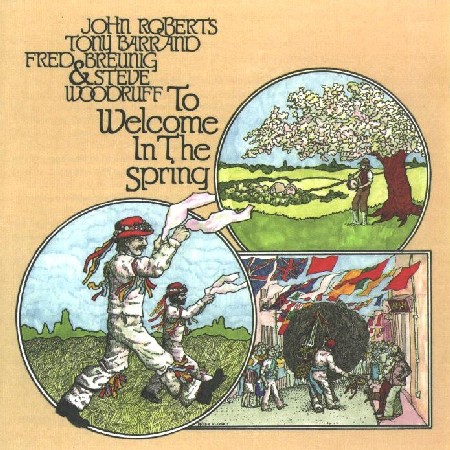 | |||||||||||||||||||||||||||||||||||||||||||||||||||
|
GHM-205 To Welcome In The Spring | |||||||||||||||||||||||||||||||||||||||||||||||||||

|
|||||||||||||||||||||||||||||||||||||||||||||||||||
| |||||||||||||||||||||||||||||||||||||||||||||||||||
| Lyrics for each song can be accessed by following the links in the playlist above. | |||||||||||||||||||||||||||||||||||||||||||||||||||
| TECHNICAL INFORMATION | |||||||||||||||||||||||||||||||||||||||||||||||||||
|
John Roberts: vocals, guitar, banjo and concertinas Produced by John Roberts, Tony Barrand and Bill Spence, 1980 To Welcome in the Spring was recorded May, 1979 at a live concert in Guilderland Center, NY sponsored by Old Songs, Inc., a not-for-profit corporation dedicated to preserving traditional music. This recording has been restored from vintage reel-to-reel tapes. You may notice occasional technical imperfections intrisic to the original tape. ©1980 Golden Hind Music This recording was previously released as Front Hall FHR-022. |
|||||||||||||||||||||||||||||||||||||||||||||||||||
| SONG NOTES | |||||||||||||||||||||||||||||||||||||||||||||||||||
|
|||||||||||||||||||||||||||||||||||||||||||||||||||
|
January 1 marks the beginning of the calendar year when the new, depicted as a babe in diapers, replaces the worn out old man with a long, white beard who carries an hour glass, the sands of which have run their course. This is, however, a strange time to celebrate for it is still Christmas-tide and the harsh part of winter, the last parting shot of the old year, has yet to be felt. Prior to the establishment of our current calendar, the new year used to fall on what is now March 21, the Spring Equinox, and people danced and sang carols in praise of the awakening of renewed life in the earth, in plants and animals. This was the time of the White Goddess, called Flora by the Romans, whose sacred animal was the Hare (the Easter Bunny) and whose life giving fertility was symbolized, in the visits of the carol singers and mummers, by gifts of decorated eggs, so-called "Pace" or "Pasch" eggs. The people of Europe had readily accepted the Nativity of Jesus as the new reason for celbrating the winter solstice, so the church continued its highly successful practice of giving Christian meanings to the pagan rituals of what became Easter-tide: the Roman festival of Februation, a purification prior to planting, became Candlemas, the purification of the Virgin; the 40 days and nights of fasting and celabacy following the orgy associated with planting (Shrove Tuesday) became Lent; and the dramatic death and resurrection of the Passion was a compellingly vivid image parallelling the rebirth of the land. Even the name of the main event on the church calendar was taken from a German incarnation of the white goddess, Eostre or Eastre. The new ideas were widely accepted and mixed with the old ones; much as we happily associate the nativity with the ancient, pagen Christmas tree and the giving of gifts, so the Easter bunny and chocolate Easter eggs have made their way into church and home. The conjuction of new and old ideas is found most strongly in the carols of the season. This was also true for the midwinter carols as we tried to show in the program, "Nowell Sing We Clear." Carolling, however came to be associated almost exclusively with Christmas, in part, perhaps, because neighbors were more generous at the season but also because the message of Easter is philosophically more difficult than that of Christmas. It is easy to be festive over the birth of a child, but the message of the crucifixion is one of personal sacrifice for a cause and is, therefore, more challenging even though it climaxes with the joy of resurrection. The ideas in the texts of the Easter carols are, often, sombre in mood, but musically they are as exciting as the more familiar Christmas songs. Like their midwinter cousins, they are based on tunes which derive from the ancient circle song-dances or "caroles." Further, it was the gypsies and country people whose lives were most affected by the changing seasons who kept the old springtime carols and customs alive. These are flourishing again in the wake of the renewed interest in folk ways and one can once again hear the May carols which accompany the night wanderings on May Eve, when fresh boughs and flowers are left on a loved one's doorsteps, and one can see maypoles and morris dancing on town greens and city streets in both England and North America. It is our hope that we can help music, song and dance to become an important aspect of the celebration of the renewed hope and life which is felt once the mountains of snow have finally thawed and the first fresh shoots appear in the garden. The words of an unknown author, stitched into a sampler by May Morris, the daughter of William Morris, capture the spirit of this wish: |
|||||||||||||||||||||||||||||||||||||||||||||||||||
|
|||||||||||||||||||||||||||||||||||||||||||||||||||
|
Happy New Year and a joyous May! |
|||||||||||||||||||||||||||||||||||||||||||||||||||
|
© Golden Hind Music |
|||||||||||||||||||||||||||||||||||||||||||||||||||